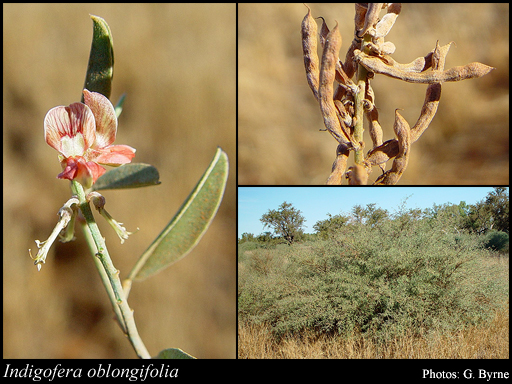- Reference
- Fl.Aegypt.-Arab. 137 (1775)
- Conservation Code
- Not threatened
- Naturalised Status
- Alien to Western Australia
- Name Status
- Current
Erect, spreading shrub, to 2 m high. Fl. pink&yellow, Apr or Jun or Sep. Brown sandy clay, white clay over limestone, alluvial soils. Coastal areas, roadsides.

Scientific Description
Erect, shrub, spindly shrub (broom-like). Stems terete, not spiny, hairy; pustules or glands absent. Leaves or phylloclades clearly present, compound, alternate, 10-20 mm long, hairy, with simple hairs, flat with flat margins; margins entire; tubercles absent, leaflets 1-4; pustules or glands absent. Stipules present and persistent to older leaves, 2-6 mm long, without glands, ribless. Pedicel 0.5-1 mm long. Bracteoles present but early deciduous, hairy (?). Calyx 1.5-3 mm long, hairy, with simple hairs; pustules or glands absent. Corolla multicoloured, mostly yellow or pink, with some yellow or pink spots, streaks or blotches; standard 5-6 mm long, hairy at least in part, not auriculate, wings 4.5-5.5 mm long, not auriculate, keel 5-7 mm long, not beaked, not auriculate, hairy at least in part. Stamens ten, at two different levels (filaments alternately long and short); filaments united in an open sheath with one free stamen, 5.2-5.5 mm long. Ovary hairy or glandular; style 6-6.5 mm long, hairy or glandular towards the base, bearded (with a tuft of hairs at apex), terete. Fruit dehiscent (a pod or follicle), sessile or subsessile, not constricted between the seeds, round in cross-section, not beaked. Flowers in April, June and September. Occurs in the Northern and Eremaean Botanical Province, in the Pilbara and Dampierland IBRA regions.
Distribution
- IBRA Regions
- Dampierland, Pilbara.
- IBRA Subregions
- Chichester, Pindanland, Roebourne.
- IMCRA Regions
- Pilbara (nearshore).
- Local Government Areas (LGAs)
- Broome, Karratha, Port Hedland.